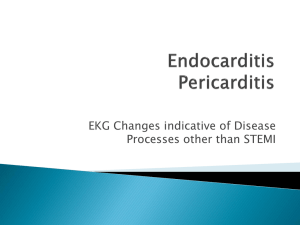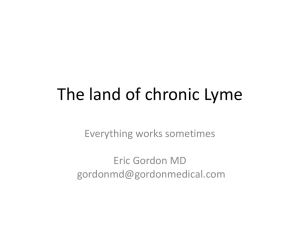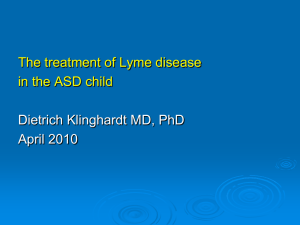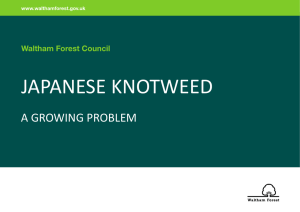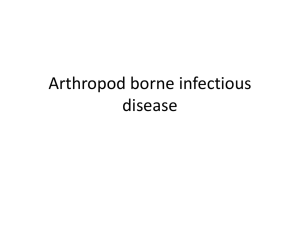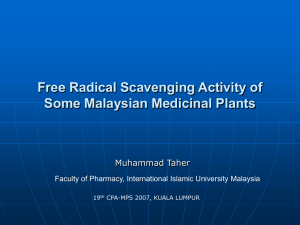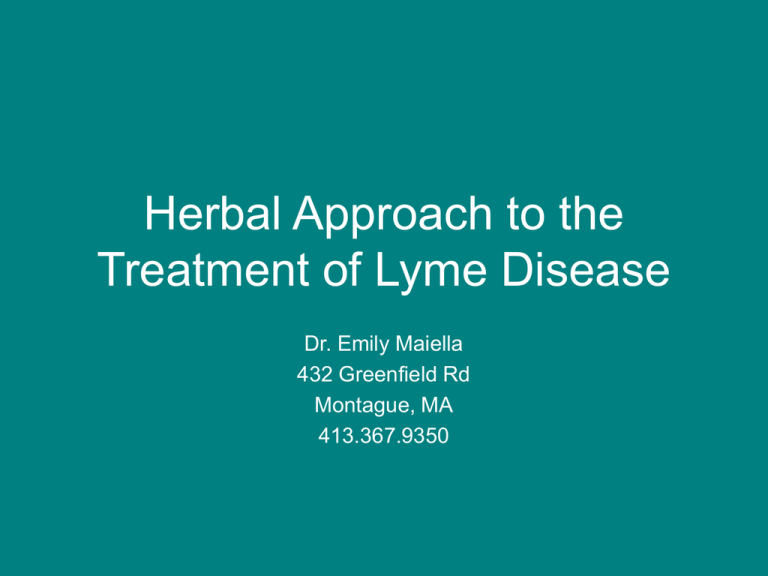
Herbal Approach to the
Treatment of Lyme Disease
Dr. Emily Maiella
432 Greenfield Rd
Montague, MA
413.367.9350
The treatment of
Lyme has changed
• In 2006 I began going to ILADS conferences.
The attendance was not big, usually in just an
auditorium. There was never any
presentations regarding natural medicines
and the treatment of Lyme.
• This year, I attending my 7th ILADS
conference. Not only was the conference
enormous, reaching maximum capacity in at
least 4 big conference rooms, but there was
an entire “track” dedicated alternative
medicine. The treatment of Lyme has shifted.
• Alternative treatments are more
cumbersome, but it is more joyful when
you get there and more congruent in
keeping with the needs of the earth.
Listen
Lyme disease is a highly variable and adaptive
organism. There is no one treatment that will work for
all patients. Every incidence is unique and the
practitioner must see the person in front of them.
Patients need individual attention so they can tell their
entire story from the beginning. There is information
in these stories that help to guide where the
treatment begin.
What was your life like before this illness?
“The response of the host makes the
disease”. It is often not the bugs that create
the symptoms, but our immune systems
response to them is far more relevant.
Evolution with Peaceful
Intentions
Treatment should always keep in mind that our
immune-system is in a never- ending training and
adaptation program. We are evolving. The same is
true for the microbes.
I truly believe that you can’t heal when fearful. I’m
here to help counter the dooms-day reports
My hope is that we can seek a peaceful inner state in which microbes are welcome as long as they
contribute to the greater whole. It is difficult to
understand Lyme disease in this way, but my hope
is that our unconscious and our immune-system
does/can.
Plant adaptogens have a great potential in helping us
in this necessary process of evolution.
We are Super Organisms!
• The evolutionary process has made become
a symbiote which contains over 3.3 pounds of
microbial mass in our gut, with over 10 trillion
cells that continuously interact with and
modify our genetic phenotype.
• The number of bacteria living within the body
of the average healthy adult human are
estimated to outnumber human cells, 10 to1.
We live in their world….
• 90% of us is bacterial DNA
• 10% of us is our own DNA
Parasite elimination prior to Lyme
treatment is important. (ie lung worm for
chronic fatigue patients)
Layered Treatment model
The treatment of Lyme and co-infections is a layered process,
because as a patient moves through treatment, it is not
uncommon for the symptom picture and pathology to change.
•
•
•
•
Outer layer: What the immune system is currently challenged with.
Second Layer: The next dominant pathogen/pathology that will
manifest in a change in the symptomatic pattern
Third Layer: Weaker pathogen which will come forward next with a set
on milder symptoms.
Innermost Layer: Deepest layer that is probably related to your
genetic susceptibility.
Foundation Health
There are some foundational aspects of health that I
make sure that are addressed during (or even before)
treatment.
~sleep
~inflammation
~hormones (thyroid, adrenal, insulin and sex hormones)
~toxic exposures (metals, EMF’s, mold), including
emotional/spiritual (ongoing and past)
~diet
~immune system imbalance
Hierarchy of Treatment
• 1) Correct basic physiological parameters
(pH, electrolytes, HPU/KPU, constipation,
hormones)
• 2) Immune Modulation (which accounts for
most of the symptoms)
• 3) Detox of biotoxins and exogenic toxins
• 4) Decreasing microbial and parasitic burden.
Note that the last step is killing the microbes.
INFLAMMATION
• Borellia uses specific mechanisms, primarily
inflammation, to breakdown the collagen tissues.
• It is where this breakdown occurs that determines where
the symptoms emerge. If it is in the joints, arthritis
presents. In the meningies, neurological Lyme is seen. In
the heart, Lyme carditis presents.
• Cytokines are inflammation chemicals made by the
immune system in chronic diseases. They cause most of
the symptoms. At the beginning of treatment when killing
lyme spirochetes with antimicrobials (or yeast with
antifungals), cytokines are made in even greater
amounts, causing a person to feel much worse.
Curcumin/tumeric, bromelain, boswellia, ginger and
querectin are some great anti-inflammatories.
SLEEP
• Often disturbed in chronic Lyme disease. Lack of
adequate sleep worsens pain, increases fatigue, and
suppresses the immune system.
• It appears that in response to infection, the excess
inflammatory cytokines produced by the immune system
decrease the output of sleep inducing hormones
(melatonin) to the sleep centers of the brain. Sleep in the
few hours before midnight is most restorative. There are
many options here.
• Melatonin very useful due to it’s wide range of
therapuetic benefits http://www.lef.org/magazine/mag2008/aug2008_Beyond-Sleep-NewMedical-Applications-for-Melatonin_01.htm
Hormones
Low hormones occur often in chronic Lyme disease. Again,
cytokines, decrease the effective functioning of the
hypothalamus, pineal and pituitary glands (in your brain).
These parts of the brain produce chemicals that induce
sleep and that regulate hormonal systems.
Normally this part of the brain releases messengers such
as thyroid stimulating hormone (TSH),
adrenocorticotropin hormone (ACTH), and follicle
stimulating hormone (FSH) to stimulate the thyroid,
adrenal glands, and sex hormone organs, respectively.
Hormones Cont.
• A better way to check hormone status is to measure the actual
hormone levels like T4/T3 (thyroid), or cortisol/dhea (adrenals),
or estrogen/progesterone/testosterone (sex hormones).
• However, these tests give a broad range of normal, therefore a
person could have normal range testing for each of the
hormones but still have clinically low hormones. Because of the
unreliability of testing, treatment for low hormones should occur
if there are clinical symptoms of low hormones as long as
treatment does not increase hormone levels above the upper
end of normal.
Adrenals and Thyroid
Adrenal Insufficiency: rule this out if you have fatigue,
recurrent infections, poor recovery from infections, low
blood sugar with shakiness and irritability relieved by
eating, low blood pressure and dizziness on standing,
afternoon crashing, and sugar cravings. Natural
medicines include: Ashwagandha, schizandra, licorice,
rhodiola
Prolonged antibiotic therapy will deplete the adrenals.
Low Thyroid: fatigue, achiness, low body temperatures,
cold intolerance, weight gain, constipation, changes in
menstrual periods. Can be confused with adrenal
insufficiency. Natural medicines: Lots of different options
here, just be aware of iodine content as too much can
make thyroid conditions worse.
Auto-immune imbalances
T cells and B cells from some patients with
chronic Lyme disease are reactive not only
against Borrelia burgdorferi-specific antigens
but also against various host (self) antigens.
This mimicry might generate autoimmune
inflammatory reactions that could be
responsible for arthritic as well as some
neurological symptoms associated with chronic
Lyme disease.
This happens with people that have specific HLA
genotypes (HLA-DR4 and 2)
Diet and Lifestyle choices
• This is going to be one of the most challenging journey that you
will embark on. There is a lot to be done on your part while the
medicines do their job. My treatment plan includes dietary
changes with emphasis on nutrient dense foods such as seeds,
nuts, free range eggs, balanced 4:1 omega 6 to omega 3 oil,
organic protein foods, and green leafy vegetables. I usually
recommend all grain/flour, sugar, processed foods, and
hydrogenated fats to be removed. Building a strong nutritional
foundation is paramount and is accomplished by raising the
mineral base, stabilizing the electrolytes, increasing and
balancing essential fatty acids.
• Minimizing aggravating factors: This is my toxic 50 gallon
barrel analogy. What have you put into your barrel over your
life? Time to get rid of it. Think toxic homes, toxic
relationships, heavy metal overload, gut dysbiosis, yeast over
growth and food allergies (to think of a few). A food allergy test
and a stool microbiology test is recommended prior to starting
treatment
Herbal protocol
Many options and protocols available. I tend to use Uncaria,
Andrographis, Smilax, Polygonum, Teasel, Stephania garlic and
Guacucium. Dosage is highly variable. Some patients need a
few drops while others require tablespoons. It is difficult for the
spirochetes to develop immunity to this type of an herbal
regimen due to the complex phytochemicals of the herbs.
Herbs have the ability to address many aspects of dysfunction:
~They are anti-inflammatory which help to stop the breaking down
of collagen.
~They support the formation and strength of collagen in the body.
~They allow the doctor to design specific treatment interventions
for the unique symptom picture of the patient.
~Immune system modulators to correct immune dysfunction.
~ Anti-spirochetals to control infection. The use of antispirochetals continues to get lower and lower on the list as time
has gone on.
Polygonum cuspidatum
QuickTime™ and a
decompressor
are needed to see this picture.
QuickTime™ and a
decompressor
are needed to see this picture.
QuickTime™ and a
decompressor
are needed to see this picture.
QuickTime™ and a
decompressor
are needed to see this picture.
Japanese Knotweed
An invasive botanical in almost every
place where Lyme has emerged. Nature
has a way of helping.
Japanese Knotweed shuts down the
inflammatory pathways initiated by the
spirochetes. It inhibits lipoxygenase,
prostaglandin E and NF kB, which are
all up-regulated in Lyme disease.
Japanese knotweed
• Knotweed crosses the blood brain barrier. It is
specific for inflammation in the meninges (stiff neck
and headaches)
• It is a potent antioxidant and has protective effects on
the brain. It calms the central nervous system and
helps with arthritis symptoms in Lyme disease.
• Knotweed is an herb and drug synergist meaning that
when it is used with antibiotics, it makes them
powerfully effective even in cases where they
previously failed. Take Japanese Knotweed along
with antibiotic therapy.
Japanese knotweed
• It modulates the immune system by either raising or lowering
immune function as required in each unique person (immune
modulating), thereby reducing the dynamics involved in
autoimmunity.
• It is an angiogenesis modulator and controls the healthy
generation of blood vessels. It stimulates microcirculation to the
eyes (due to it’s High content of resveratrol) and joints thus
helping to facilitate the movement of drugs or herbs to those
locations.
• It is cardioprotective and helps to remove endotoxins, which is a
benefit to those with Herxheimer reactions during treatment.
Japanese knotweed
• Traditional Chinese Medicine has used it as a
blood-moving herb, to resolve inflammation,
stagnation, and poor circulation, but also as a
supportive herb, to counter debility and
immune fatigue. Because it is considered to
be an herb that slows down the aging
process (together with its relative Polygonum
multiflorum, also known as Fo Ti and Shou
Wu), millions of Chinese use Japanese
knotweed to prolong youth.
Japanese knotweed
• Similar to astragalus, it has an adaptogenic or
immune-balancing quality, which makes this
an effective ally in balancing the body’s
immune responses; it can stimulate immune
cells, as in Lyme disease, or modulate them,
as in an autoimmune disease. By supporting
the blood flow to difficult-to-reach regions of
the body, Japanese knotweedʼs antimicrobial
and anti-inflammatory actions can reach the
eyes, joints, and brain.
Other published functions of
knotweed
• Peer review literature (pubMed): Many gram neg and
gram pos bacteria, Anti-viral, Hepatitis B and C, many
types of cancer (esp hepatocelluar cancer),
cardiovascular disease, anti-inflammatory.
• Other published positive effects: antimicrobial, protects
against microbial endotoxins, Lowers cholesterol and
lipids, Increases wound healing, Ischemic heart
disease, Leukemia, Stimulates fibroblasts
(proliferative effect), Rheumatoid arthritis, Psoriasis,
Increases bone mass, Reduces auto-immunity,
Strongly neuroprotective (ALS, Alzheimer,
Parkinson’s, MS, cerebral ischemia).
Dosage for knotweed:
• Whole herb (Aka the root) (Hu Zhang) standardized to
8% total resveratrol and 10 mg resveratrol. 500 mg
tablet.
• Use 3-4 caps 3-4 times/day. Work up slowly to this dose
• Contraindications: Pregnancy, Consider carefully when
giving with blood thinners (synergistic effect), may cause
a metallic or odd taste in the mouth.
andrographis paniculata
• King of Bitters
QuickTime™ and a
decompressor
are needed to see this picture.
Andrographis paniculata
• Andrographis has been used traditionally in
China to treat all manners of febrile diseases
and infections. It is used throughout China
and India for its apparent anti-parasitic and
antimicrobial actions to treat syphilis, malaria,
and worms; and for swollen lymph glands
with fever, abscesses, and lung and sinus
infections. It was used in many cultures to
treat syphilis until antibiotic drugs became
more available.
Andrographis paniculata
• Recent scientific research, has
indicated that it has antimicrobial
effects, it supports immune function,
increases interleukin-2 production, and
has some cancer-targeting actions. (Singha
PK, Roy S, Dey S. Antimicrobial activity of Andrographis paniculata. Fitoterapia.
2003;74:692-694; Kumar RA, Sridevi K, Kumar NV, Nanduri S, Rajagopal S.
Anticancer and immunostimulatory compounds from Andrographis paniculata. J
Ethnopharmacol. 2004;92:291-295; Rajagopal S, Kumar RA, Deevi DS,
Satyanarayana C, Rajagopalan R. Andrographolide, a potential cancer
therapeutic agent isolated from Andrographis paniculata. J Exp Ther Oncol.
2003;3:147-158.)
Andrographis paniculata
a simple pubmed search….
1.
2.
3.
4.
5.
kidney protective (rapid excretion via kidneys)
anti-spirochetal
crosses blood brain barrier
protects heart muscle, anti-inflammatory
potent modulating effect on mast cell and neutrophil
activity: turns off inappropriate mast-cell allergic
reactions in tissue
6. enhances liver function
7. protective effects against inflammation-mediated
neurodegeneration of brain, spinal cord and CSF
Andrographis paniculata
8.
9.
10.
11.
12.
13.
Filarial diseases
leptospirosis
malaria (suggesting strong effect against Babesia)
periodontal bacteria (gum disease)
AIDS
cancers: prostate, breast, colon, anal, stomach ,skin
melanoma, leukemia
14. TB
15. Tonsilitis, pheumonia, herpes, E. coli, snake bites
Andrographis paniculata
• Dosage: 400 mg capsules standardized to 10%
andrographolides. Start with 1 cap 4 times/day. Slowly
increase to 3 caps 4 times/day. Stay on this dose till
Lyme sx significantly decreased, then slowly decrease
dose.
• It needs to be taken at least three times a day as it
moves out of the body rapidly.
• Stop during severe Herxheimer reactions. 1 year
• Contraindications: andrographis lowers progesterone
(natural contraceptive), pregnancy, and acute gallbladder
disease. The main side effect of andrographis is that 1%
of the people that take it will get severe hives that takes
as long as two months to resolve. Start with a lower dose
to watch for s/e’s
Smilax glabra
• Roots: 6-8 feet long
QuickTime™ and a
decompressor
are needed to see this picture.
Qu ickTime™ and a
decompresso r
are need ed to see thi s pi cture.
QuickTime™ and a
decompressor
are needed to see this picture.
Smilax glabra, spp.
• Sarsaparilla root has been used for
centuries by the indigenous peoples of
Central and South America for sexual
impotence, rheumatism, skin ailments,
and as a general tonic for physical
weakness.
Smilax
• Amazonian medicine folk use sarsaparilla
root internally and externally for leprosy and
other skin problems (such as psoriasis and
dermatitis.)
• Just FYI: Leprosy can be common in areas
where the disease is carried by armadillos
(and in the Amazon, armadillos are "on the
menu" in indigenous diets).
Smilax and Syphilis
• European physicians from as early back as
1536, considered sarsaparilla root a tonic,
blood purifier, diuretic, and sweat promoter,
BUT mostly as an syphilis cure. Since this
time, Smilax roots have had a long history of
use for syphilis and other sexually-transmitted
diseases throughout the world.
• It was registered as an official herb in the
U.S. Pharmacopoeia as a syphilis treatment
from 1820 to 1910.
More uses of Smilax
• A U.S. patent was awarded in 2003
describing these flavonoids to be effective in
treating autoimmune diseases and
inflammatory reactions through their
immunomodulating effects. Sarsasapogenin
and smilagenin were subjects of a 2001 U.S.
patent which reported that these Smilax
steroids had the ability to treat senile
dementia, cognitive dysfunction, and
Alzheimer's disease.
What is an endotoxin anyway?
• Clinical research has validated the traditional
use of sarsaparilla for skin conditions such as
psoriasis, eczema, acne, and leprosy.
(NEJM).
• One of the possible mechanisms of action in
psoriasis is sarsaparilla's blood cleansing
properties. Pts. with psoriasis have been
found to have high levels of endotoxins
circulating in the bloodstream (endotoxins are
cell wall fragments of bacteria). Sarsaponin,
one of sarsaparilla's main steroids, was found
to bind to these endotoxins and remove them,
Smilax and the Herx reaction
• As bacteria break down, they release
endotoxins that normally are cleansed from
the gut by the lymphatic system and the liver.
If the endotoxins are excessive and cannot
be eliminated, the body experiences a toxic
overload. This toxic overload triggers an
inflammatory reaction as the body moves into
a fight pattern, causing a flare-up of
symptoms of arthritic pain, skin inflammation,
and irritability. Sarsaparilla’s binds endotoxins
in the intestines before they get into the
bloodstream.
Smilax glabra (Sarsaparilla)
(another pubmed search)
1.
2.
3.
4.
5.
6.
7.
Leptospirosis
Treponema pallidum (syphilis)
liver flukes (clonorchis sinensis)
shigella and salmonella
Leprosy
TB
fungal skin infections
Smilax glabra
other published/clinical
evidence
• Lyme endotoxin binding
• Lessens Herxheimer reactions
• Improvement in mental and psychological parameters in
chronic lyme and syphilis
• Modulates immune responses esp w/ autoimmune
dysregulation
• Arthritis (anti-inflammatory and pain relieving)
• Psoriasis and eczema, Reduces skin breakdown
• Neuroprotective (crosses blood brain barrier)
• Improves liver function, including Hepatitis C
• Lessens fatigue
• Increases libido
• Asthma, hay fever, rhinitis
Smilax Glabra
• Dosage: 425-500 mg caps 1-3 caps 3-4 times/day.
Increase slowly to full dosage, stay on it for 2 months,
then slowly reduce to maintenance dose of 1 caps 3
times/day. At least 1 year
• Contraindications: Increases digitalis, digoxin (CHF and
dysrhythmias ) and Bismuth absorption, increased
elimination of hypnotic drugs.
Uncaria tomentosa
• Cat’s Claw; Amazonian vine.
Make sure that only the bark is
harvested, as some companies harvest the root, and is therefore in
danger of over harvesting.
QuickTime™ and a
decompressor
are needed to see this picture.
QuickTime™ and a
decompressor
are needed to see this picture.
QuickTime™ and a
decompressor
are needed to see this picture.
Uncaria tomentosa
In lyme, it acts as a immune potentiator, which
helps to raise CD57 white blood cell counts.
Anti-inflammatory and analgesic, so useful for
joint and muscle pain associated with Lyme.
Especially good for neuroborreliosis, chronic
fatigue and cognitive decline.
Cat’s claw
• The Asháninka Indian priests in Perú
used Catʼs claw to regulate
disturbances between a personʼs body
and spirit.
Cat’s Claw
TOA’s (Tetracyclic oxindole
alkaloids)
or
not?
In some cases, people have experienced that they cannot
tolerate full-spectrum Cat's Claw, however, they can
tolerate TOA-free. I have not found the studies on TOAfree to be very convincing. It is actually the TOA’s that
help the central and peripheral nervous system. The
POA’s (Pentacyclic oxindole alkaloids) which is another
type of alkaloid in Cat’s Claw, helps with the immune
modulation, so both are important. I generally suggest
using full-spectrum Cat's Claw.
For a great discussion on the differences: http://www.raintree.com/toa-poa-article.htm#.UYf5-StATms
Teasel: Pinyin name in is Xu Duan,
“restore what is broken”
QuickTime™ and a
decompressor
are needed to see this picture.
QuickTime™ and a
decompressor
are needed to see this picture.
QuickTime™ and a
decompressor
are needed to see this picture.
Teasel-from an eclectic
perspective
• When a plant has a prickly doctrine of
signature (like eluethero, nettle and
raspberry) they will help you to break
something down and weave something new.
Used to tease cloth, wool in particular
(tapestry).
• Eclectic herbalist say that is will mend things
that are broken, esp in energetic field.
Adrenal pulses will change when using it.
Teasel
• Lyme disease spirochetes attack and
penetrate into collagen tissue, affecting the
joints and tendons throughout the body,
teasel root seems to fit right in. Rather than
killing the bacteria, teasel helps to change the
bodyʼs environment, so that the body itself
can kill off the Lyme bacteria by bringing the
bacteria into the bloodstream, where it can
detoxify.
Teasel: Traditional Chinese
Medicine
• Yang tonifying herb, Dipsacus fortifies the
lower back, knees and bones.
• It has a positive effect on the sinews and
joints as well and is used for pain and
stiffness from decreased Kidney energy or
from traumatic injury.
• It is also used to promote the movement of
blood and to repair damaged tissues.
Teasel
• Side of the road medicine, just like Lyme is a side of
the road disease
• Only small amounts necessary. Begin with 1 drop, 3
times daily, and gradually increase the dosage to
about 10 drops, 3 times daily.
• Can be taken internally as a tincture or decoction,
applied topically in a salve or liniment, or one could
address all aspects of the disharmony and choose
internal and external treatment simultaneously.
Stephania
(Mountain Turtle)
• Parts used: rootlet or vine. The root which
looks like a boulder and grows on top of the
ground, which a vine grows from
QuickTime™ and a
decompressor
are needed to see this picture.
QuickTime™ and a
decompressor
are needed to see this picture.
Stephania
S. tetrandra and S. cepharantha)
Lyme specific functions:
~Decreases inflammation in the CNS
(Bell’s palsy, uveitis, eyes)
~Decreases inflammation in the joints
~decreases fluid build up in tissues and
joints
~helps to heal endothelium
~Immunomodulation
Stephania S. tetrandra and S. cepharantha)
Peer review literature/Science: effective against:
1. Potent anti-inflammatory:
~Reduces the pro-inflammatory cytokines: IL-1 beta, ILalpha, TNF-a, IL-6, IL-8 and COX-2 (especially in CNS
and joints)
~Reduces NF-kappa B and IL-6 during
neuroborreliosis, ~Modulates HLA-DR expression
2. Treatment of silicosis (also breast implant immune
complications)
3. Protects endothelium from endotoxin damage
4. Reduces vascular permeability
5. Bell’s palsy (decreased edema and vascular
extravasation AND by decreasing IL-6, IL-8 and TNF-a)
6. Free radical scavenger: Inhibits h202-induced neuronal
cell death)
Stephania
7. Inhibits toxic glutamate levels in brain
8. Ca-channel blocker: some studies show higher
potency than verapmil for the tx heart
disease/hypertension)
9. Retinopathy (modulates formation of new blood vessels
and improvement of vision, specifically for diabetic
retinopathy)
10. Malaria (and Babesia)
11. Inhibits cancer cell proliferation and multi-drug
resistance in cancer
12. Anti-fibrotic/anti-scar formation
13. Blocks abnormal histamine release/stabilizes mast
cells
Stephania: why aren’t we
using this?
• In Japan, there is a proprietary herbal formula
called cepharnatha, which consists of the five
main alkaloids in Stephania c.
• It’s widely available there, and is used for the
tx of chronic inflammatory disease, radiation
induced leukopenia, asthma and alopecia
areata (all peer reviewed).
• Dosage: 1 tsp, 3 times per day. Do not use
with AV block or severely hypotensive, or if
taking Ca channel blocker, beta blocker or
digoxin
Artemesia annua
Traditional Chinese Medicine has used
sweet wormwood for over 2,000 years
to treat fevers, inflammations, and
bacterial infections, particularly malaria
and other parasites. Artemisinin, a
naturally occurring component of
wormwood, is a potent antimalarial and
is considered to be about 90% effective
in curing uncomplicated malaria.
Artemesia annua
• However, in 2006, the World Health
Organizationʼs Global Malaria Programme
issued an ultimatum to the pharmaceutical
industry to phase out artemisinin as a
monotherapy against malaria, because
malaria parasites were becoming resistant to
artemisinin as a single oral drug. WHO now
recommends using artemisinin combination
therapies (ACTs).
•
(Rehwagen C. WHO ultimatum on artemisinin monotherapy is showing results. BMJ.
.)
2006;332:1176
Artemesia annua
Different protocols exist:
Artemisinin:100 mg caps. 5 caps 3 times per day, 2
days in a row each week with grapefruit juice. 3
weeks on, 1 week off. 1 year needed for Babesia
OR:
Artemisinin: 100 mg 3x/day for 30-40 days
OR
Artemisinin (200-300 mg two times per day, 3 wk on, 1
wk off taken with grapefruit juice. This dosing has
been shown in studies to be 20% more effective for
malaria than the pharmaceutical treatments.
Source: Allergy Research For EBV: 2 caps Bid for months
Klinghardt Lyme cocktail
• 200-400 mg artemisinin, 100 mg glutathione, 10 ml phospholipids
exchange 9to make liposomal artemisinin (detox, anti-viral, anti-bab,
anti-lyme, shuttle agent, biofilm breaker): Then add:
• D-galactose 95 grams), to increase ATP dramatically
• 10-20 drops of 20% propolis tincture
• Lyme herbs (Quitessence or from me), variable dosage
• 15 ml Rechtsregulat (enzyme mix to break biofilms)
• micro-silica 100 mg
• co-curcumin (ayush herbs) 1 tsp plus pippli (2 caps)
• vitamin c powder 2000 mg
• acai powder (anti-microbial, anti-oxidant, 1 tsp
• 1/2 glass grapefruit juice (important for artemisinin absorption)
• 1/2 glass water
KLINGHARDT LYME COCKTAIL
cont….
• OPTIONAL:
• Macuna powder 1 tsp to increase L-dopa
and neurotransmitter production
• Grapefruit seed extract 10 drops
• Freese died garlic 4 caps
• Energized Neem: 2 caps 3 times/day
Some over looked issues
These overlooked issues can turn an asymptomatic
patient into an ill patient.
1. Parasites (the elephant in the living room)
2. EMF exposure
3. Mold
4. dental issues (amalgams, root canals, cavitations,
electrogalvanism, reactive materials)
5. Viruses
6. methylation blocks
7. tonsillitis (ozone injections, cryotherapy)
8. sinus infections such as MARCoNS (uses Symbioflor
nasally like a nasal probiotic)
9. decreased regulatory peptides (such as MSH,
oxytocin, ADH, VIP, and melatonin). The first few
are more causal and the last six are symptoms
caused by the primary illness but they need to be
fixed to address the overall condition.
Thriiive.com"top"10"list
Helpful life style choices for both parents and children. Thrive is a
think tank of experienced ASD and Lyme practitioners who
believe that Autistic children have congenitally acquired Lyme
from their Mother
1. Life: add pleasure,reduce stress
2. Energy: add sunshine and nature, reduce EMF’s at night
3. Water: add purity and structure, reduce contaminants
4. Food: go organic and choose real food
5. Exercise get moving: 30 min for you, more for the child
6. Tests: utlilize more energetic testing, less blood draws/lab
7. Emotions: decrease negative self talk, allow yourself to feel
8. Body:treat and eliminate focal lesions (scars, dental, organs
9. Supplements: add minerals, decrease multi vitamins (sensitize
towards food allergies), calcium (biofilm)
10. Detoxify: open windows, no carpets, no shoes inside, wash
hands, no chemicals in home or garden, cups: no soap residues



